Dynamic Failure Experimental Study of a Gravity Dam Model on a Shaking Table and Analysis of Its Structural Dynamic Characteristics
Abstract
:1. Introduction
2. Design of the Gravity Dam Experimental Model on the Shaking Table
2.1. The Emulation Concrete Material
2.2. Gravity Dam Model Design and Sensor Placement
2.3. Experimental Procedure
3. Damage Identification Methods
3.1. Frequency Spectrum Characteristic Parameters
3.2. Modal Parameter Identification Based on Numerical Algorithms for Subspace State Space System Identification
4. Test Result Analysis
4.1. Strain Responses and Failure Mode Analysis of the Gravity Dam Model
4.2. Analysis of the Acceleration Amplification Coefficients
4.3. Frequency Spectrum Analysis
4.4. Modal Parameter Identification
5. Conclusions
- (1)
- A model material, named emulation concrete, was selected and prepared; this material consisted of heavy sand, heavy alumina powder, cement, quick-setting agent, and water. This model material exhibited high density, low elastic modulus, and adequate strength, ensuring that the gravity dam model could be smoothly hoisted to the shaking table without damage.
- (2)
- Using the developed emulation concrete material, a gravity dam model was designed and fabricated. Accelerometers and strain gauges were arranged at different locations on the dam body to capture the acceleration and strain responses under various operational conditions. The SE7 to SE14 conditions were selected for the analysis, revealing that the gravity dam model had nonzero mean plastic strains from SE7 to SE10, indicating that microscopic cracks were not visible to the naked eye. Subsequently, visible cracks appeared at the top and middle portions of the gravity dam model. Visible cracks appeared at the top of the gravity dam model during the SE11 condition and continued to develop, and visible cracks in the middle portion of the gravity dam model appeared during the SE13 condition and formed penetrating cracks in the SE14 condition.
- (3)
- The acceleration amplification coefficients of various accelerometers under different conditions were analyzed. The acceleration amplification coefficient of accelerometer a1 at the dam crest noticeably decreased with the progression of seismic loading conditions, indicating a gradually decreasing trend. This aligns with the characteristics of damage appearing near the dam crest and continuously developing. The largest decrease in the amplification coefficient for accelerometer a1 occurred during the SE12 condition, corresponding to visible and significant crack damage near the dam crest. This crack damage affected the transmission of dynamic loads.
- (4)
- The frequency spectrum characteristics of acceleration response point a1 under different conditions were analyzed, and statistical parameters for spectrum characteristics, denoted as , were proposed for the analysis. The results show that the peak frequency of the spectrum for accelerometer a1 is 42.22 Hz during the SE7 to SE10 conditions, gradually decreasing in the SE11 to SE14 conditions. The parameter showed a gradual decreasing trend with the advancement of seismic loading conditions. The parameter exhibited a smaller decrease during the SE7 to SE10 conditions and a more pronounced decrease during the SE11 condition, corresponding to the visible small cracks near the dam crest. Clearly, parameter is more sensitive to visible small crack damage than is the peak frequency in the spectrum and the acceleration amplification coefficient.
- (5)
- A modal parameter analysis of the gravity dam model was conducted using the N4SID method. Visible small cracks appeared during the SE11 condition, resulting in no stable modes for the gravity dam model under these conditions. However, the gravity dam model exhibited relatively stable modes during the SE7 to SE10 transition. The analysis of the identified values for the first-order frequency and damping ratio during the four conditions revealed that the natural frequency of the gravity dam model gradually decreased with the development of damage, while the damping ratio continuously increased, indicating an increase in energy dissipation due to damage progression.
- (6)
- Future work will consider water loading in the gravity dam model experiment on the newly established underwater shaking table in the Structural Seismic Laboratory at Hohai University, and the damage patterns and dynamic characteristic parameters of the two different experiments will be compared to consider the influence of water loading on the dynamic characteristics and damage patterns of gravity dam structures.
Author Contributions
Funding
Institutional Review Board Statement
Informed Consent Statement
Data Availability Statement
Conflicts of Interest
References
- Bayraktar, A.; Türker, T.; Akköse, M.; Ateş, Ş. The effect of reservoir length on seismic performance of gravity dams to near- and far-fault ground motions. Nat. Hazards 2010, 52, 257–275. [Google Scholar] [CrossRef]
- Calayir, Y.; Karaton, M. Seismic fracture analysis of concrete gravity dams including dam–reservoir interaction. Comput. Struct. 2005, 83, 1595–1606. [Google Scholar] [CrossRef]
- Zymelka, D.; Togashi, K.; Takeshita, T.; Yamashita, T.; Kobayashi, T. Practical evaluation of printed strain sensors based on long-term static strain measurements. Sensors 2021, 21, 4812. [Google Scholar] [CrossRef] [PubMed]
- Esmaielzadeh, S.; Ahmadi, H.; Hosseini, S.A. Damage detection of concrete gravity dams using Hilbert-Huang method. J. Appl. Eng. Sci. 2018, 8, 7–16. [Google Scholar] [CrossRef]
- Shu, Y.; Wang, G.; Lu, W.; Chen, M.; Yan, P.; Wang, Y. Stability assessment method of damaged concrete gravity dams subjected to penetration explosion. Eng. Struct. 2022, 267, 114683. [Google Scholar] [CrossRef]
- Calayir, Y.; Karaton, M. A continuum damage concrete model for earthquake analysis of concrete gravity dam–reservoir systems. Soil Dyn. Earthq. Eng. 2005, 25, 857–869. [Google Scholar] [CrossRef]
- Zhai, Y.; Zhang, L.; Cui, B.; Zhang, H.; Ma, T. Evolution criteria of overall damage of concrete gravity dam body and foundation under near-fault ground motion. Structures 2022, 43, 594–605. [Google Scholar] [CrossRef]
- Alegre, A.; Oliveira, S.; Mendes, P.; Proença, J.; Ramos, R.; Carvalho, E. Seismic safety assessment of arch dams using an ETA-based method with control of tensile and compressive damage. Water 2022, 14, 3835. [Google Scholar] [CrossRef]
- Andonov, A.G.; Iliev, A.; Apostolov, K.S. Towards Displacement-based seismic assessment of concrete dams using non-linear static and dynamic procedures. Struct. Eng. Int. 2013, 23, 132–140. [Google Scholar] [CrossRef]
- Ouzandja, D.; Berrabah, A.T. Deterministic Seismic damage analysis for concrete gravity dams: A case study of Oued Fodda dam. Acta Mech. Autom. 2023, 17, 347–356. [Google Scholar] [CrossRef]
- Alembagheri, M.; Ghaemian, M. Seismic assessment of concrete gravity dams using capacity estimation and damage indexes. Earthq. Eng. Struct. Dyn. 2013, 42, 123–144. [Google Scholar] [CrossRef]
- Su, H.; Zhang, S.; Wen, Z.; Li, H. Prototype monitoring data-based analysis of time-varying material parameters of dams and their foundation with structural reinforcement. Eng. Comput. 2017, 33, 1027–1043. [Google Scholar] [CrossRef]
- Asteris, P.; Tzamtzis, A. Nonlinear seismic response analysis of realistic gravity dam-reservoir systems. Int. J. Nonlinear Sci. Numer. Simul. 2003, 4, 329–338. [Google Scholar] [CrossRef]
- Qiu, J.; Zheng, D.; Xu, P.; Cao, Q.; Chen, Z.; Xu, B. Online structural damage state identification of concrete arch dams under dynamic loads using a recursive TVARX approach. Struct. Health Monit. 2023, 22, 2038–2063. [Google Scholar] [CrossRef]
- Chen, J.; Liu, X.; Xu, Q. Numerical simulation analysis of damage mode of concrete gravity dam under close-in explosion. KSCE J. Civ. Eng. 2016, 21, 397–407. [Google Scholar] [CrossRef]
- Cabaleiro, M.; Moutinho, C.; González-Gaya, C.; Caetano, E.; Rosales-Prieto, V.F. Analysis of stiffness of clamped joints versus bolted joints in steel structures by means of accelerometers and shaking table tests. Sensors 2021, 21, 4778. [Google Scholar] [CrossRef]
- Cataldo, A.; Roselli, I.; Fioriti, V.; Saitta, F.; Colucci, A.; Tatì, A.; Ponzo, F.C.; Ditommaso, R.; Mennuti, C.; Marzani, A. Advanced video-based processing for low-cost damage assessment of buildings under seismic loading in shaking table tests. Sensors 2023, 23, 5303. [Google Scholar] [CrossRef]
- Chen, J.; Wang, M.; Fan, S. Experimental investigation of small-scaled model for powerhouse dam section on shaking table. Struct. Control Health Monit. 2013, 20, 740–752. [Google Scholar] [CrossRef]
- Xu, Q.; Liu, B.; Chen, J.; Li, J.; Wang, M. Shaking table test and numerical simulation study of the reinforcement strengthening of a dam. Buildings 2022, 12, 1955. [Google Scholar] [CrossRef]
- Mridha, S.; Maity, D. Experimental investigation on nonlinear dynamic response of concrete gravity dam-reservoir system. Eng. Struct. 2015, 80, 289–297. [Google Scholar] [CrossRef]
- Wang, M.; Chen, J.; Xiao, W. Experimental and numerical comparative study on gravity dam-reservoir coupling system. KSCE J. Civ. Eng. 2018, 22, 3980–3987. [Google Scholar] [CrossRef]
- Cheng, L.; Tong, F.; Yang, J.; Zheng, D. Online modal identification of concrete dams using the subspace tracking-based method. Shock. Vib. 2019, 2019, 7513261. [Google Scholar] [CrossRef]
- Zar, A.; Kang, F.; Li, J.; Wu, Y. Vibration-based damage detection of arch dams using least-square support vector machines and salp swarm algorithms. Iran. J. Sci. Technol. Trans. Civ. Eng. 2022, 46, 4441–4462. [Google Scholar] [CrossRef]
- Guo, T.; Zong, Y.; Zhu, R.; Zhang, M.; Soh, C.K. Vibration characteristics and comfort evaluation of a large shake table during operation. Earthq. Eng. Struct. Dyn. 2023, 52, 3702–3726. [Google Scholar] [CrossRef]
- Costa Junior, A.G.; Riul, J.A.; Montenegro, P.H.M. Application of the subspace identification method using the N4SID technique for a robotic manipulator. IEEE Lat. Am. Trans. 2016, 12, 1588–1593. [Google Scholar] [CrossRef]
- Hachicha, S.; Kharrat, M.; Chaari, A. N4SID and MOSEP algorighms to highlight the ill-conditioning into subspace identification. Int. J. Autom. Comput. 2014, 11, 30–38. [Google Scholar] [CrossRef]
- Van Overschee, P.; de Moor, B. N4SID: Numerical algorithms for state space subspace system identification. IFAC Proc. Vol. 1993, 26, 55–58. [Google Scholar] [CrossRef]
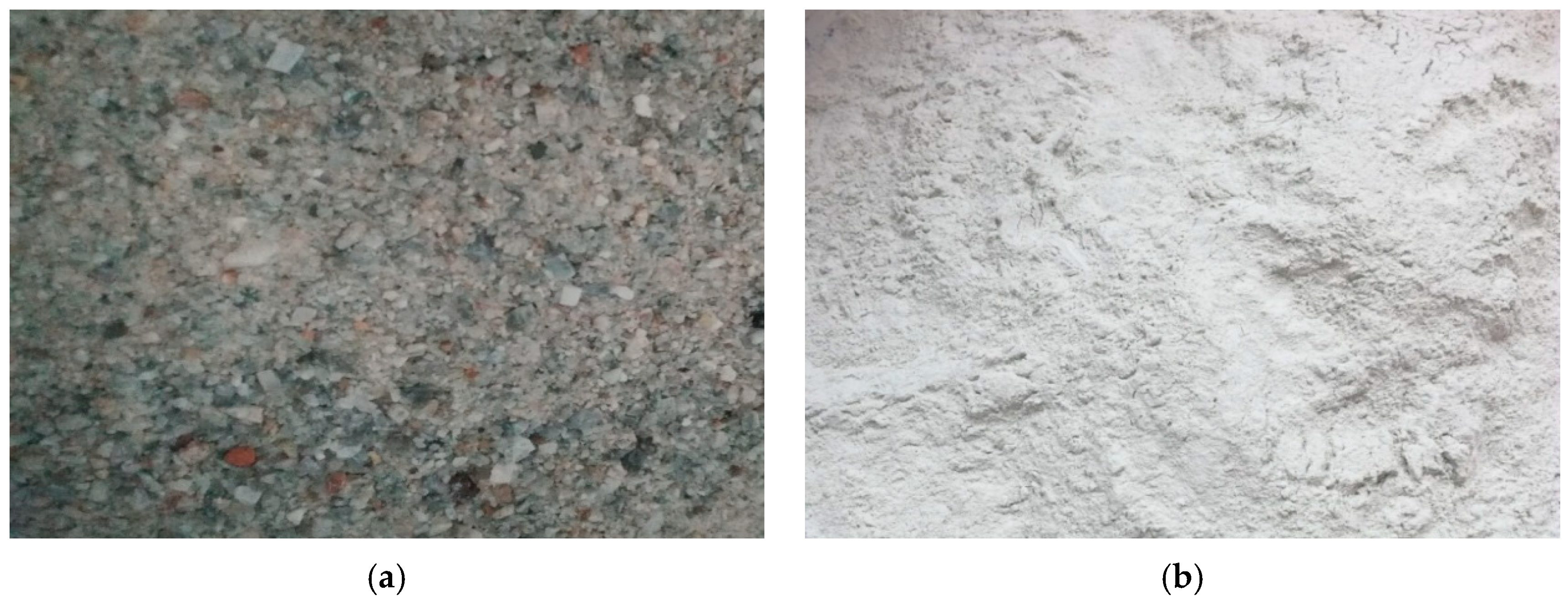

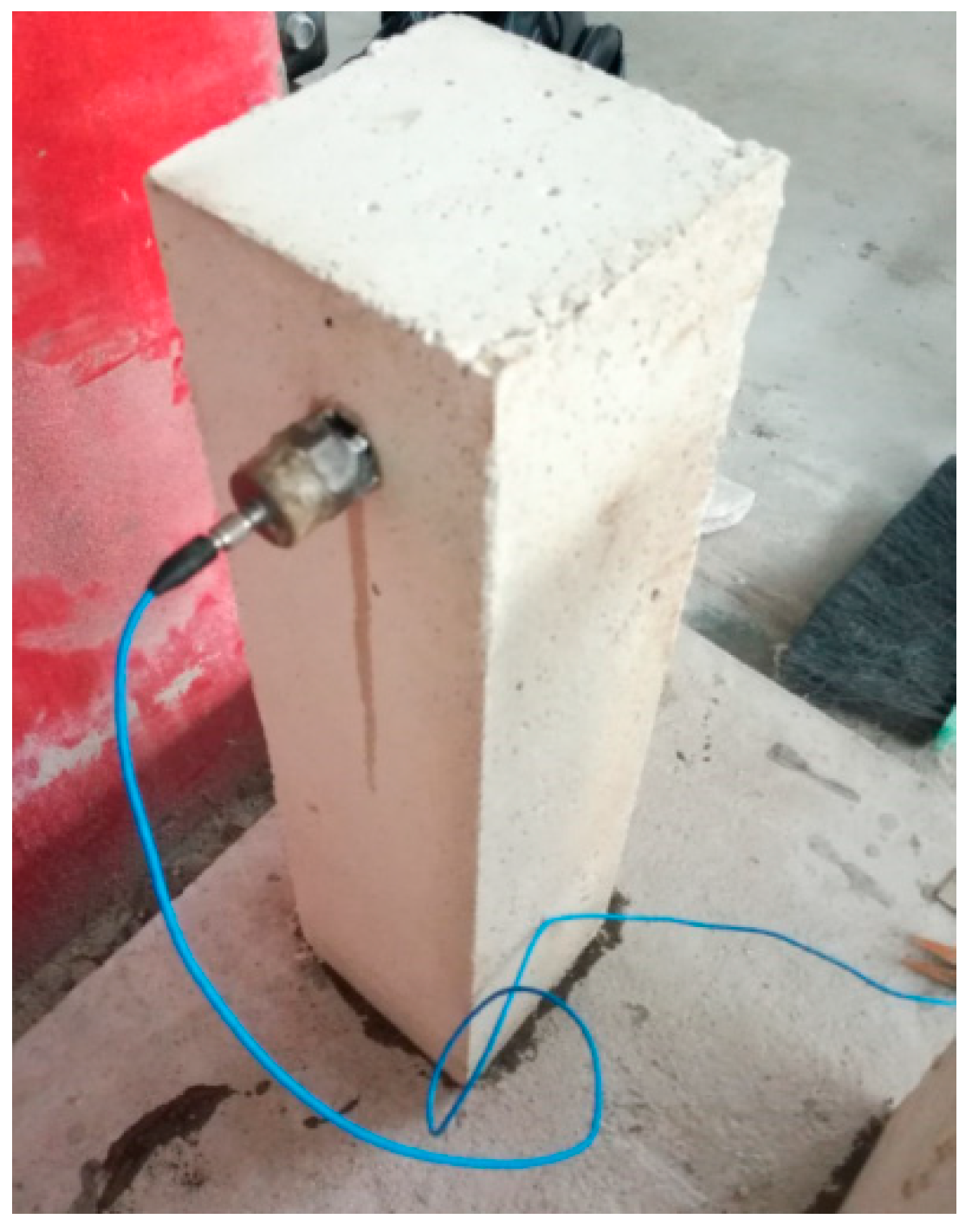
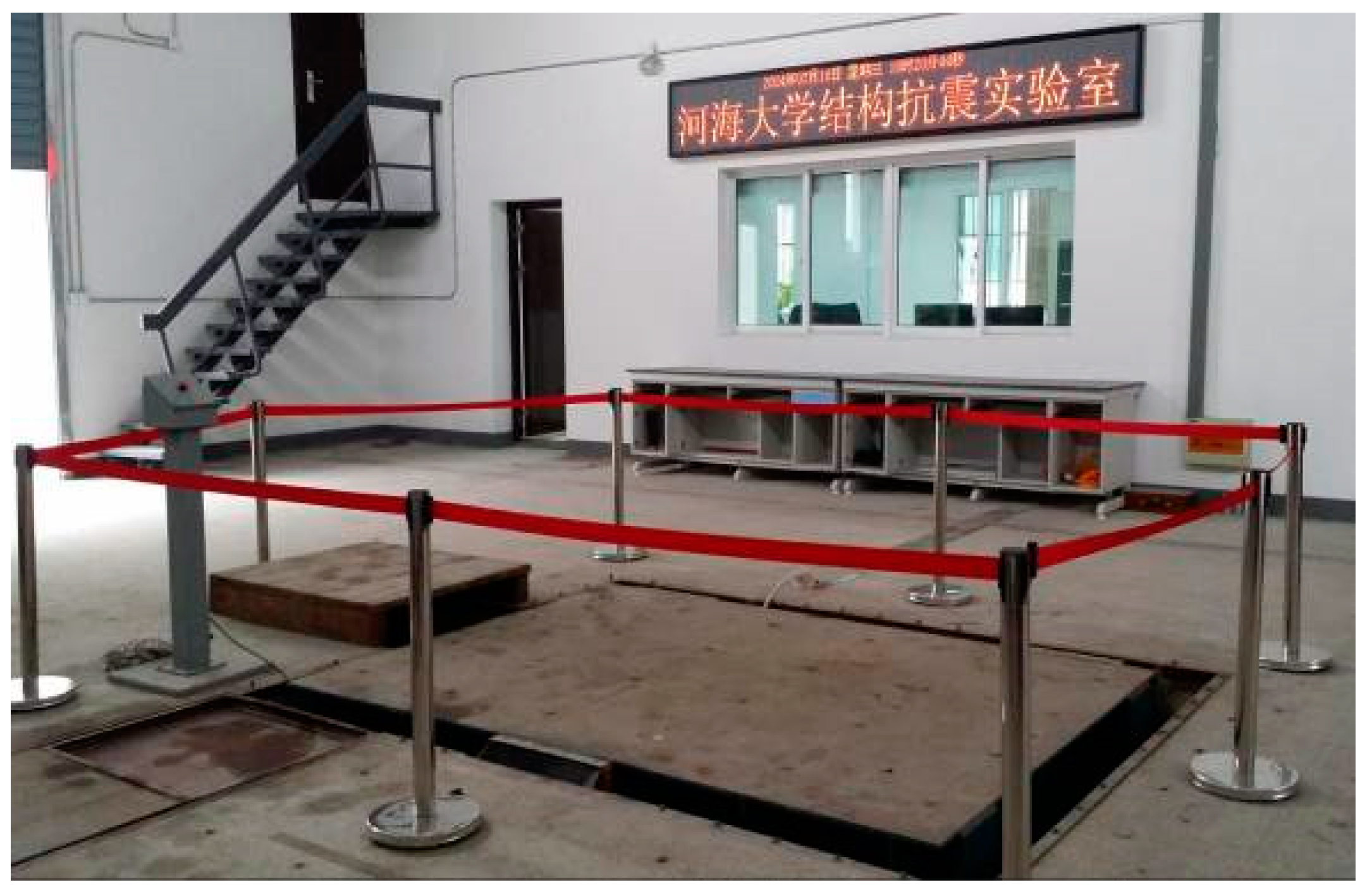





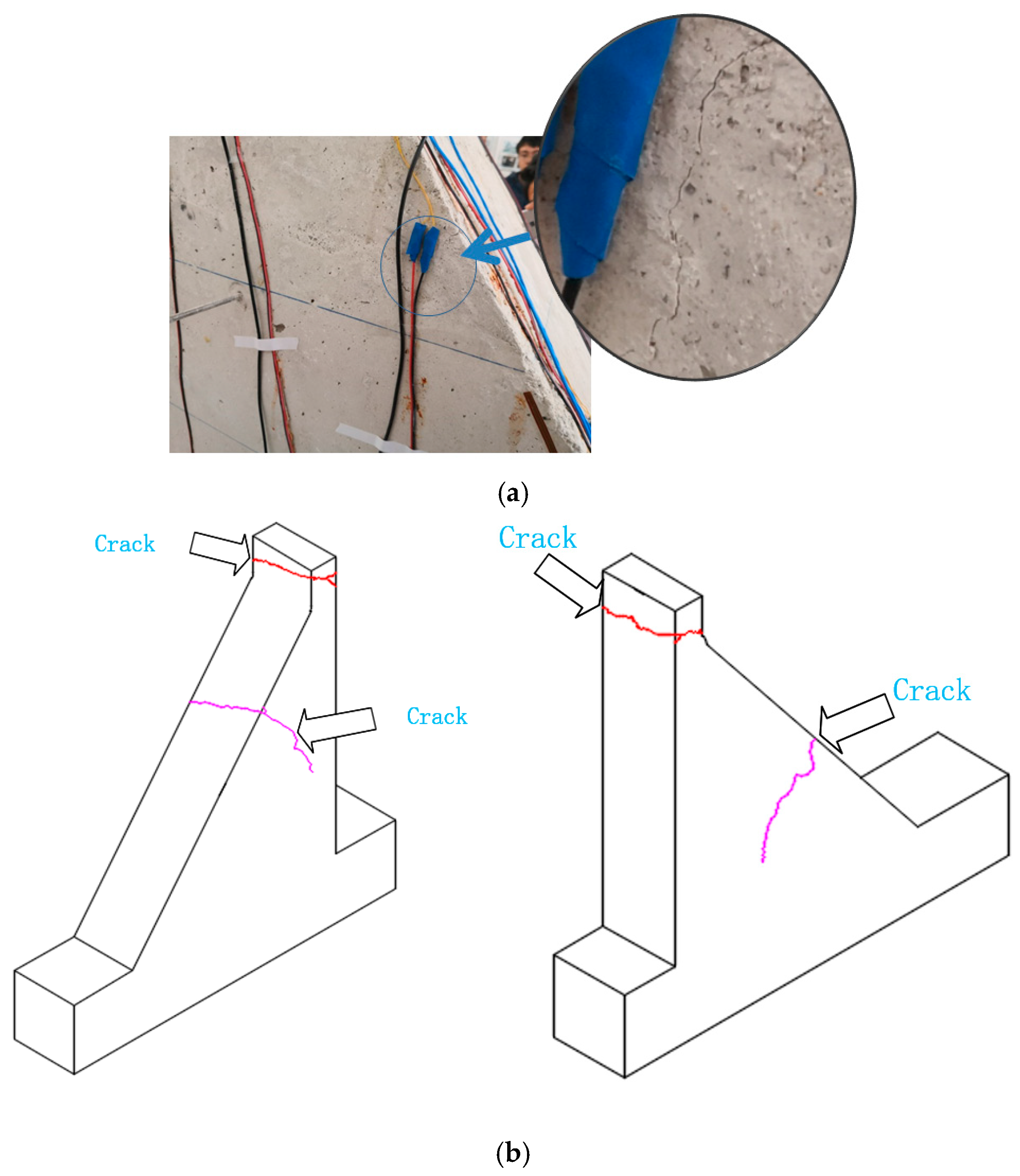
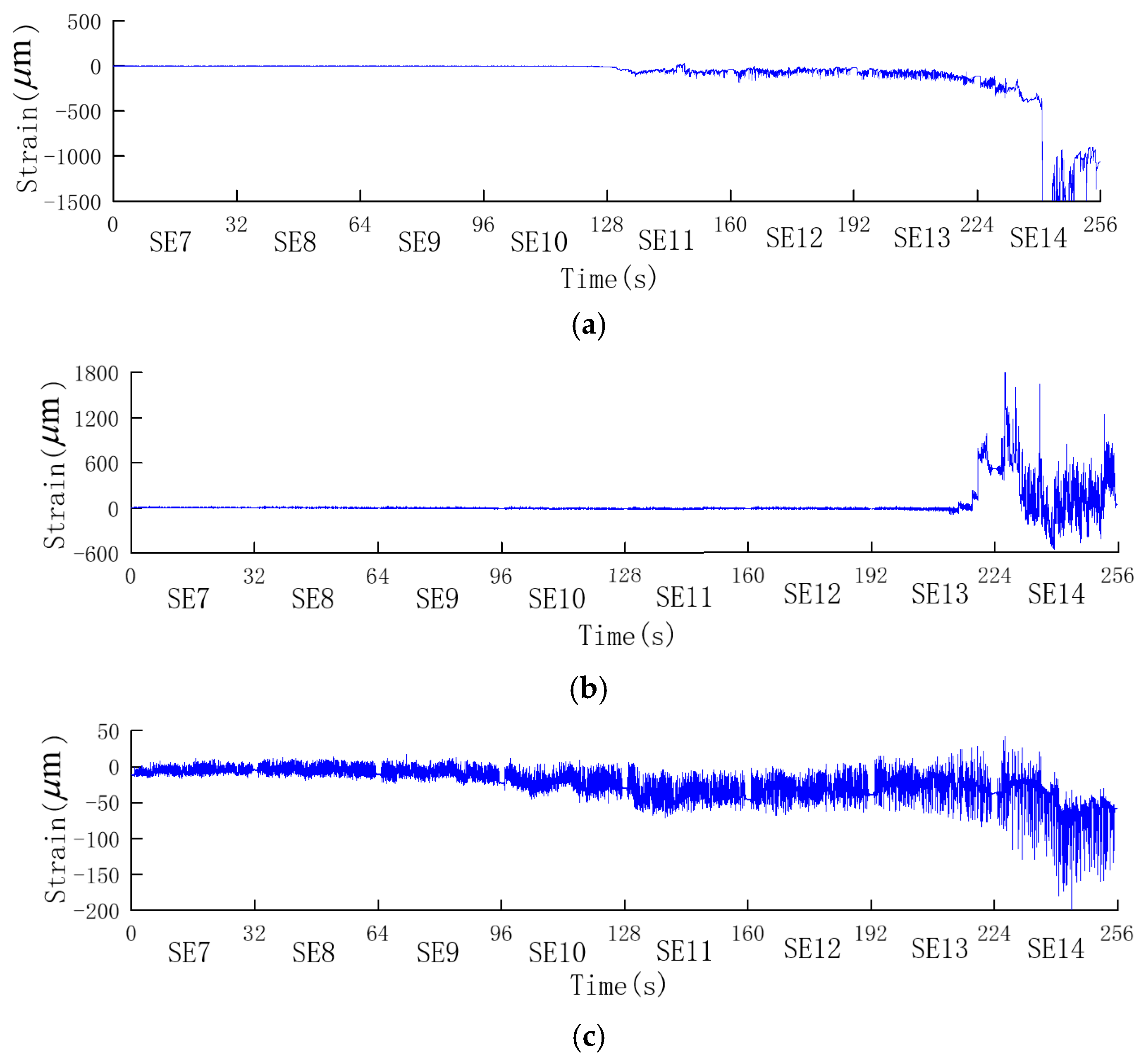
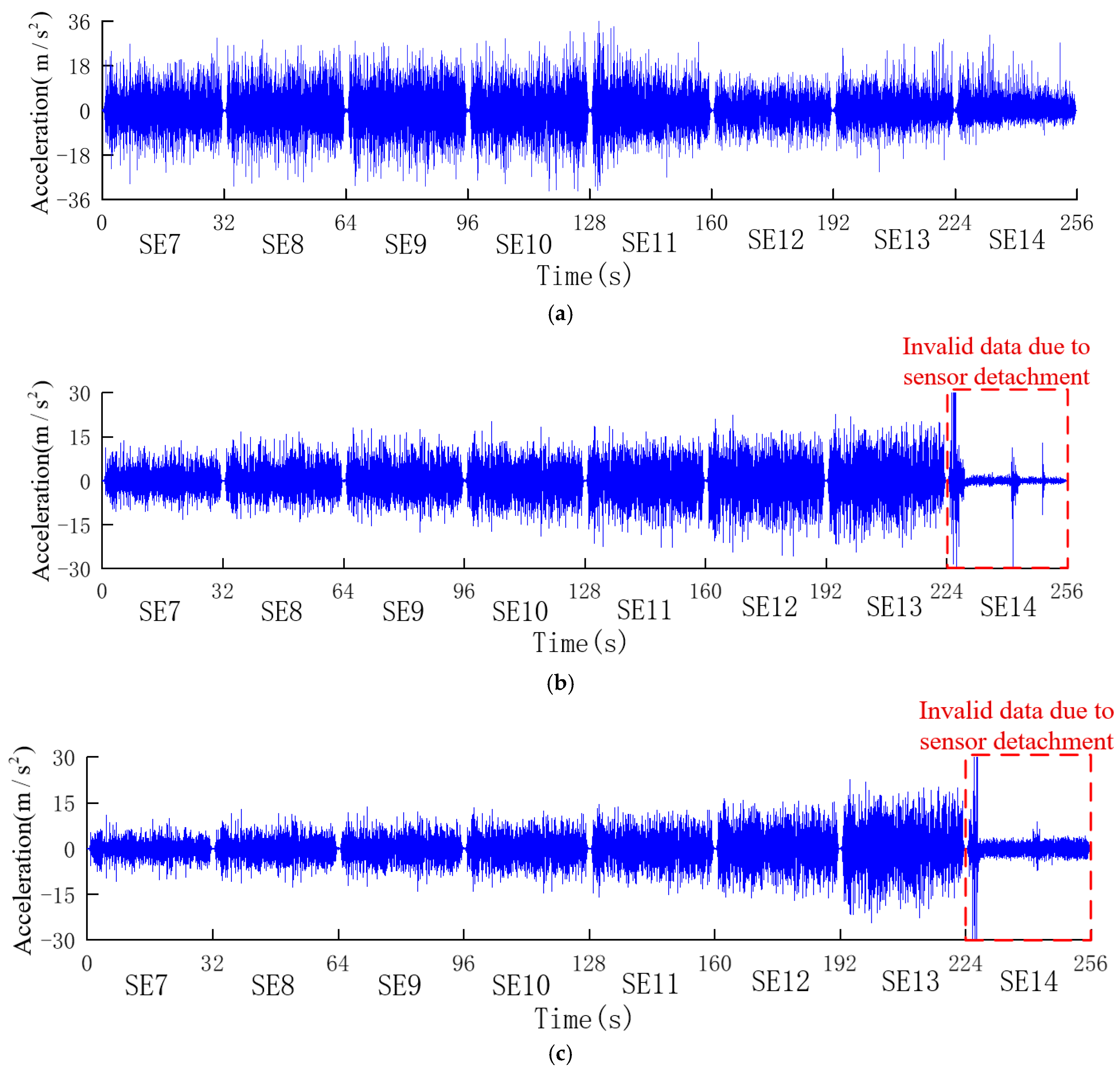


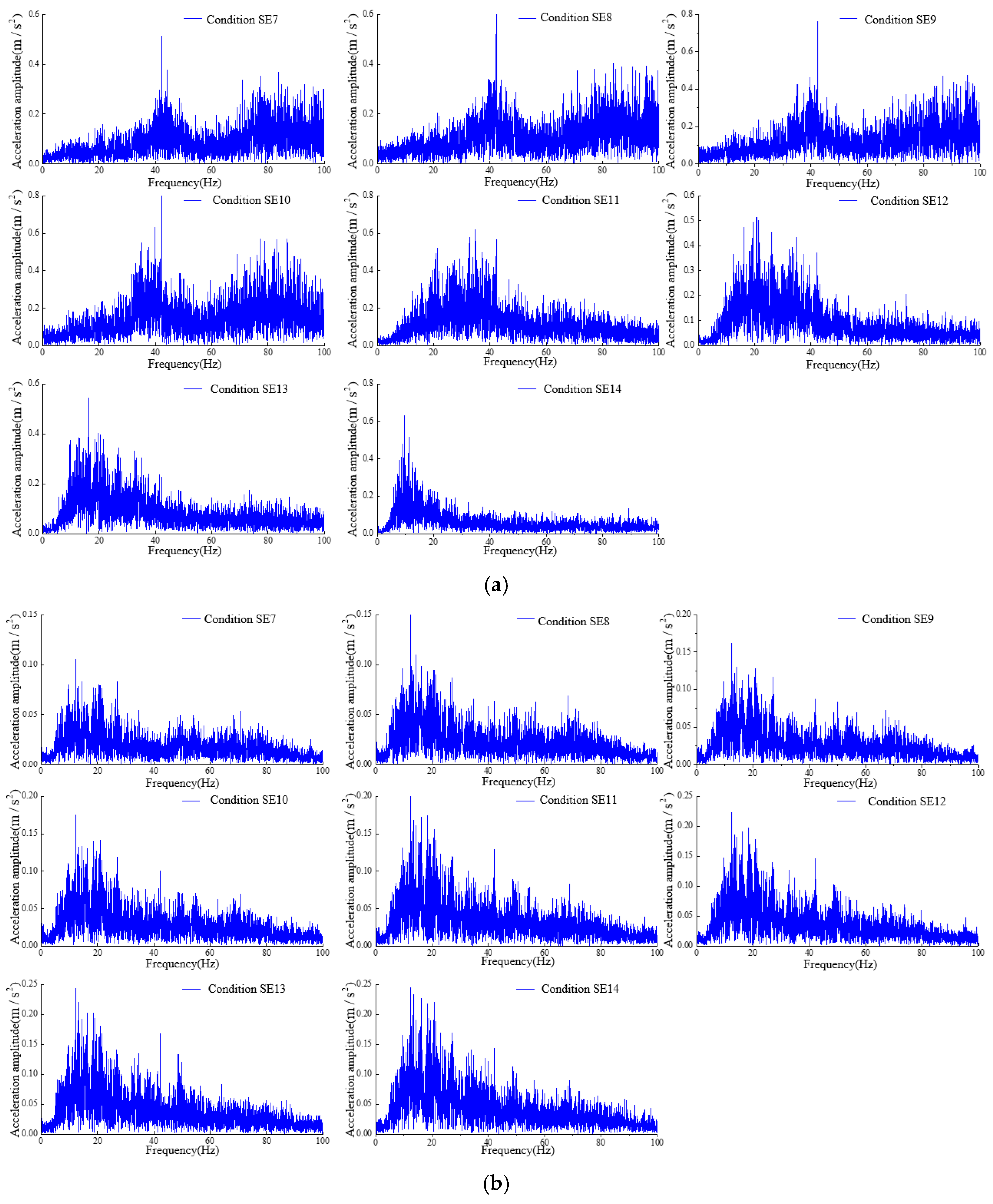

| Experimental Conditions | Input Waveform | Experimental Conditions | Input Waveform |
|---|---|---|---|
| WN1 | White Noise, 0.1 g | SE1 | Artificial Seismic Wave, 0.1 g |
| SE2 | Artificial Seismic Wave, 0.2 g | SE3 | Artificial Seismic Wave, 0.3 g |
| SE4 | Artificial Seismic Wave, 0.4 g | SE5 | Artificial Seismic Wave, 0.45 g |
| SE6 | Artificial Seismic Wave, 0.5 g | SE7 | Artificial Seismic Wave, 0.6 g |
| SE8 | Artificial Seismic Wave, 0.7 g | SE9 | Artificial Seismic Wave, 0.8 g |
| SE10 | Artificial Seismic Wave, 0.9 g | SE11 | Artificial Seismic Wave, 1.0 g |
| SE12 | Artificial Seismic Wave, 1.05 g | WN2 | White Noise, 0.1 g |
| SE13 | Artificial Seismic Wave, 1.1 g | SE14 | Artificial Seismic Wave,1.2 g |
| WN3 | White Noise, 0.1 g |
| Condition | SE7 | SE8 | SE9 | SE10 | SE11 | SE12 | SE13 | SE14 | |
|---|---|---|---|---|---|---|---|---|---|
| Measuring Point | |||||||||
| s1 | −3.21 | −3.32 | −3.73 | −5.93 | −52.22 | −53.56 | −86.84 | −961.0 | |
| s5 | 5.88 | 3.09 | −2.32 | −6.58 | −9.83 | −12.59 | 83.56 | 222.55 | |
| s9 | −5.94 | −4.41 | −8.32 | −21.82 | −36.95 | −30.45 | −22.66 | −41.54 | |
| Accelerometer | a1 | a2 | a3 | a4 | a5 | a6 | |
|---|---|---|---|---|---|---|---|
| Condition | |||||||
| SE7 | Positive | 29.33 | 13.76 | 10.94 | 8.31 | 7.42 | 6.62 |
| Negative | −29.68 | −13.14 | −10.80 | −8.21 | −6.62 | −6.10 | |
| SE8 | Positive | 28.40 | 16.74 | 12.82 | 9.36 | 8.51 | 8.30 |
| Negative | −30.63 | −14.16 | −12.68 | −9.89 | −8.17 | −7.52 | |
| SE9 | Positive | 28.07 | 17.95 | 13.79 | 10.35 | 9.83 | 9.69 |
| Negative | −30.66 | −17.65 | −14.14 | −10.99 | −10.07 | −8.39 | |
| SE10 | Positive | 36.94 | 20.37 | 13.46 | 11.52 | 11.00 | 9.69 |
| Negative | −37.39 | −18.91 | −14.70 | −11.44 | −10.10 | −9.26 | |
| SE11 | Positive | 37.62 | 18.71 | 14.57 | 13.97 | 10.98 | 10.21 |
| Negative | −32.33 | −22.70 | −16.04 | −14.85 | −12.70 | −11.97 | |
| SE12 | Positive | 30.62 | 22.55 | 16.51 | 14.31 | 11.86 | 11.08 |
| Negative | −24.40 | −25.67 | −17.14 | −15.41 | −13.96 | −13.26 | |
| SE13 | Positive | 28.83 | 22.55 | 18.16 | 13.23 | 12.32 | |
| Negative | −24.69 | −24.42 | −18.78 | −11.46 | −10.58 | ||
| SE14 | Positive | 30.57 | 12.13 | ||||
| Negative | −13.87 | −11.75 |
| Condition SE7 | Condition SE8 | Condition SE9 | Condition SE10 | ||||
|---|---|---|---|---|---|---|---|
| Frequency (Hz) | Damping Ratio (%) | Frequency (Hz) | Damping Ratio (%) | Frequency (Hz) | Damping Ratio (%) | Frequency (Hz) | Damping Ratio (%) |
| 42.32 | 5.67 | 41.78 | 6.26 | 41.47 | 6.58 | 40.39 | 7.72 |
Disclaimer/Publisher’s Note: The statements, opinions and data contained in all publications are solely those of the individual author(s) and contributor(s) and not of MDPI and/or the editor(s). MDPI and/or the editor(s) disclaim responsibility for any injury to people or property resulting from any ideas, methods, instructions or products referred to in the content. |
© 2024 by the authors. Licensee MDPI, Basel, Switzerland. This article is an open access article distributed under the terms and conditions of the Creative Commons Attribution (CC BY) license (https://creativecommons.org/licenses/by/4.0/).
Share and Cite
Qiu, J.; He, W.; Zheng, D.; Xu, Y.; Guo, S.; Ma, T.; Xu, P.; Liu, Y. Dynamic Failure Experimental Study of a Gravity Dam Model on a Shaking Table and Analysis of Its Structural Dynamic Characteristics. Sensors 2024, 24, 1602. https://doi.org/10.3390/s24051602
Qiu J, He W, Zheng D, Xu Y, Guo S, Ma T, Xu P, Liu Y. Dynamic Failure Experimental Study of a Gravity Dam Model on a Shaking Table and Analysis of Its Structural Dynamic Characteristics. Sensors. 2024; 24(5):1602. https://doi.org/10.3390/s24051602
Chicago/Turabian StyleQiu, Jianchun, Wenqin He, Dongjian Zheng, Yanxin Xu, Shaolong Guo, Tianxiao Ma, Pengcheng Xu, and Yongtao Liu. 2024. "Dynamic Failure Experimental Study of a Gravity Dam Model on a Shaking Table and Analysis of Its Structural Dynamic Characteristics" Sensors 24, no. 5: 1602. https://doi.org/10.3390/s24051602






